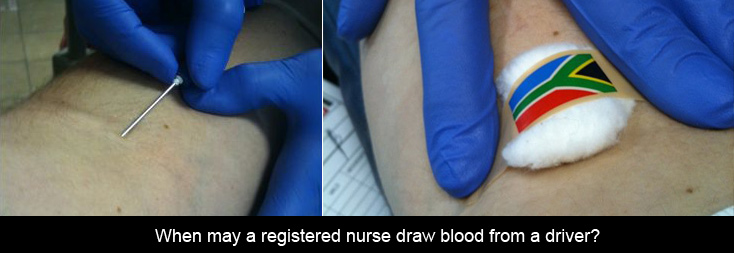When may a registered nurse draw blood from a driver?
Question to the Arrive Alive website:
“I am a Registered Nursing Sister.I often assist at roadblocks in Cape Town where I am asked to draw a blood specimen from a DIC suspect. I am looking for the Act that would protect me from a civil case when a blood specimen is obtained under duress from the suspect.
At no time do I become involved in the holding down of the suspect but am concerned that this does not protect me if one day the suspect decides to sue me for obtaining the blood sample without his consent. I would appreciate any assistance in this matter.
Michaela”
Response: We referrred this to the Experts from Justice Project South Africa, ER24 and experts on Road Traffic Legislation.
Answer:
“Dear Michaela.
It is my belief that the National Road Traffic Act, coupled with the Criminal Procedure Act would indemnify you completely against taking a blood sample without the “consent” of the person concerned, because it is plausible that the only reason that you would be asked to draw a blood specimen in the first place would be as a result of the fact that the person you are drawing said sample from would be under suspicion of operating a motor vehicle under the influence of alcohol or drugs having a narcotic effect. This usually involves the use of a handheld breathalyser or the like in making such an assessment or creating such a suspicion.
Section 65(9) of the National Road Traffic Act, Act 93 of 1996 states that: “No person shall refuse that a specimen of blood, or a specimen of breath, be taken of him or her” and as such, doing so constitutes an offence under the Act.
As a reference however, the AARTO regulations classifies the offence of “As person refused that a specimen of blood, or a specimen of breath, be taken of him or her” as an infringement and therefore it can be argued that refusing a blood sample is not a criminal offence where AARTO is in play, which is of course ludicrous in light of the fact that driving under the influence of alcohol or drugs is a criminal offence. This would be semi-relevant in Johannesburg and Tshwane, but elsewhere, the Criminal Procedure Act would apply. Cape Town is definitely one of those areas where the Criminal Procedure Act applies.
But one must also bear in mind that operating a vehicle while under the influence of intoxicating liquor or a drug having a narcotic effect is a criminal offence and a person brought to you in the roadblock would most certainly have already been placed under arrest by a Metro or SAPS police official and would therefore already be in detention under suspicion that crime.
Section 37(2)(a) of the Criminal Procedure Act states that: “Any medical officer of any prison or any district surgeon or, if requested thereto by any police official, any registered medical practitioner or registered nurse may take such steps, including the taking of a blood sample, as may be deemed necessary in order to ascertain whether the body of any person referred to in paragraph (a) (i) or (ii) of subsection (1) has any mark, characteristic or distinguishing feature or shows any condition or appearance.”
Section 37(2)(b) of the Criminal Procedure Act further goes on to state that: “If any registered medical practitioner attached to any hospital is on reasonable grounds of the opinion that the contents of the blood of any person admitted to such hospital for medical attention or treatment may be relevant at any later criminal proceedings, such medical practitioner may take a blood sample of such person or cause such sample to be taken.”
In short therefore, I would say that any person who tried to institute any legal action (civil or criminal) against you for complying with a lawful request of a police officer that you draw blood for use in the prosecution of a DWI case would have a very hard time convincing a court that any action should be taken against you – unless of course you cause grievous and permanent bodily harm to them.
It is hard to fathom how or why a person who is told to provide a blood sample when accused of driving under the influence could even begin to think that refusing such a sample would be of any benefit to them. As much as a blood test can prove guilt, it can similarly prove innocence. If someone is so adamant that they are not intoxicated, then they are clearly not thinking straight or telling the truth if they have to be physically restrained in order for a sample to be taken. That is unless of course, they are like me and are absolutely petrified of needles.
Best Regards,
Howard Dembovsky
National Chairman – Justice Project South Africa (NPC)”
Concurring response from ER24
Hi Michaela,
I also agree with what Howard has put together. I have elaborated from a Clinical Forensic Medicine aspect for you on the subject – sorry if I duplicate some of the items already addressed by Howard.
I understand your concerns fully as our paramedics also have the same fear regarding this.
The laws relating to driving under the influence is stated clearly when it says that it apply to persons on a public road, who drive a vehicle or occupy the driver’s seat of a vehicle that has its engine running.
The National Road Traffic Act 93 of 1996 stipulates:
a. Blood alcohol levels may not exceed 0.05g/100ml for normal drivers and 0.02g/100ml for professional drivers. Thus drivers with PrDP.
b. Breath alcohol levels may not exceed 0.24mg/1000nl for normal drivers and 0.10mg/1000ml for professional drivers.
c. No person detained for blood alcohol testing may consume any substance that contains alcohol unless he or she is instructed to do so or administered by a doctor.
d. A person detained may not smoke until his or her breath has been tested – important question to ask before a breath test is done.
e. A person detained may not refuse to have a specimen of blood or breath taken, HOWEVER the Constitution of the Republic of South Africa Act 108 of 1996 (ss12 (2) and 14) states
a. Everyone has the right to bodily and psychological integrity, which includes the right to security in, and control over their body
b. Everyone has a right to privacy
c. The taking of blood without consent may amount to a breach of the above
f. AND the CRIMINAL PROCEDURE ACT 51 of 1977 (s37) states
a. Any doctor or registered nurse may obtain a blood sample from an accused at the request of any police officer
b. Any doctor attached to a hospital who believes that a patient is under the influence of alcohol may obtain a blood sample which may be relevant at a later criminal proceeding.
The examination should be respected:
i. Conduct the examination in a well-lit private room or area which is suitably equipped
ii. Findings of the examiner and opinion of the examiner should be recorded in duplicate on a GW 7/54
iii. The accused should be offered to place a call, it his or her own cost, to a medical practitioner of his or her choice should it be requested. However the medical practitioner’s arrival should not unnecessary delay proceedings.
iv. If it the accused is a female, it is advised that an independent female be present during the whole examination even if the examiner is female
v. IMPORTANT – before you start your examination it is important that you insist on a written request from a police officer to conduct the examination (SAP 308(a)) – this is a document requesting the examination of a person that is arrested.
vi. Explain the nature and the purpose of the examination to the accused and obtain consent.
vii. It is always good to have a clinical examination as well to determine if the person’s ability to operate a motor vehicle is impaired. Document it well
viii. Remember the degree of intoxication cannot be judged by the smell of alcohol on the breath
ix. A blood sample is only a tool to support the clinical examination – it is advised that blood should not be forcibly be taken from an accused who refuses to give consent. (Now this is where AARTO and the NRTA is a bit weird as Howard explained)
Always make sure of the following – for your own safety
a. Ensure that the seal is not tampered with
b. Clean the skin with a non-alcoholic cleansing agent, and
c. The sample should be labelled properly with all the accused’s details as well as make sure the serial numbers match.
There is always the debate if you can take blood from a patient that received an IV on the scene, should it be an accident or trauma. The general answer to this is YES you can still take blood –
a. Take a sample from the opposite side of the IV
b. Make sure you know what time the IV was sited
c. Obtain the batch and Lot number of the IV
d. What type of IV was sited and how much fluid was given
e. What medication was administered via the IV or IM etc
f. If you are confident you can work out the levels with the Widmark’s Formula
g. According to Widmark’s equation, the amount of alcohol consumed (A) is a function of these several variables:
Equation 1
N = f(W, r,Ct ,β , t, z)
where:
N = amount consumed
W = body weight
r = the volume of distribution (a constant)
Ct = blood alcohol concentration (BAC)
β = the alcohol elimination rate
t = time since the first drink
z = the fluid ounces of alcohol per drink
Widmark’s equation relates these variables according to:
Equation 2
N = Wr(Ct + βt)
0.8z
where:
N = the number of drinks consumed
W = body weight in ounces
r = volume of distribution (a constant relating the distribution of water in the body in L/Kg)
Ct = the blood alcohol concentration (BAC) in Kg/L
β = the alcohol elimination rate in Kg/L/hr
t = time since the first drink in hours
z = the fluid ounces of alcohol per drink
0.8 = the density of ethanol (0.8 oz. per fluid ounce)
And this opens a whole new debate on the 2 hour principle to get the blood sample as you can calculate the levels back to a few hours prior to the arrest.
I hope this helps a bit.
Regards,
Werner Vermaak
Communications Manager
ER24 EMS




